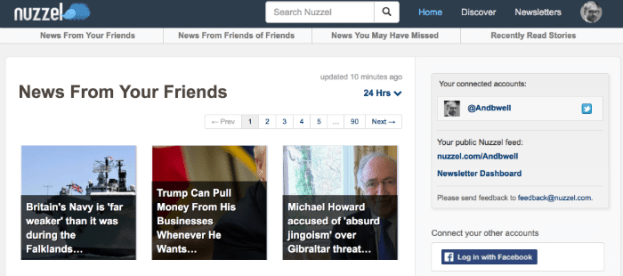
Nuzzel offers a short-cut to the most shared stories in your Twitter timeline – and is already popular with journalists. But while it’s best known for directing you to your friends’ most popular links, it has other uses. In a guest post for OJB, Andy Brightwell shows how you can use Nuzzel to burst your filter bubble, follow people in a particular location or industry, see the world from someone’s perspective, or create a niche newsletter.
Since Nuzzel added Twitter lists it’s been possible to curate ‘custom feeds’ from sets of tweeters. For journalists this means an opportunity to seek new perspectives on communities, places and politics through Twitter. Below I’ve outlined five different ways to use the feature — but first, a bit of background…
Twitter lists and Nuzzel’s ‘custom feeds’
The Twitter list feature allows you to create groups of Twitter users – including those you’re not necessarily following.
A Twitter list generates its own, separate timeline. The ‘big’ problem with the Twitter list feature has always been that your list timelines can lie dormant once you’ve curated them, away from your focus and with little attention elsewhere. This might explain why Twitter has removed an easy way for you to search for lists.
Nuzzel, however, has given Twitter lists a new lease of life. With Nuzzel, a list can offer an insight into a set of tweeters, or a particular news story, without you having to continually revisit the list.
It can also give you a way to curate a piece of content from that list – with Nuzzel’s newsletter function.
1: Using Nuzzel to follow subject and place communities

Nuzzel’s search tool allows you to find feeds that are already curated by other users. Really, these are just Twitter lists they’ve set up to check up on groups of users, so you should bear in mind that not all of them will be fantastic.
When you find a feed you like, click in to the list on Twitter to get a feel for it and check it does what it says on the label.

Still, by searching around you can find some good ‘custom feeds’ (Twitter lists of other users.)
This also works very well for local areas – particularly cities, which tend to generate good lists.
2. Break your ‘echo chamber’ by curating a feed that contrasts with your own views

Alice Thwaite, who runs The Echo Chamber Club, uses Nuzzel to browse a Twitter list that she’s put together of people with opinions that don’t – shall we say – chime with those of the liberal persuasion.
This helps Alice to understand the subjects that are exciting right-wing tweeters – and help to inform the weekly newsletter she writes, offering contrary views to liberal readers.
In order to do this, I’d suggest you create your own private Twitter list, as per these instructions. (This won’t be a publicly available feed.)
3. Duplicate a tweeter’s followers to get their perspective

I’ve had a little go at this myself, by creating a private list of everyone arch Brexit supporter Daniel J. Hannan follows.
I use it regularly to get a good sense of ‘what would Daniel think?’ – or, more pertinently, what is Daniel seeing?
Manually putting together a list can be hard – and time consuming – but there’s a free way to copy lists from other people. You can add various lists together with the tool, to create your own super lists.
If you’re wondering how this might be useful, well it’s one way to understand a specific public figure. Donald Trump – for example – only follows 42 users, so putting together this feed was easy. (And proof, were it needed, that he spends a lot of time looking at Fox News.)
4. Create a private feed to monitor a specific group

People have been using private lists to monitor Twitter activist groups, extremist communities, and political parties for a long time. With Nuzzel you can turn a labour of love into a quick scan.
This opens up this to something more of us could actually do – either to find stories or to help provide an insight into a particular group of people or organisations.
I’d definitely recommend keeping Twitter lists like this private, although you can find some good lists already curated on Twitter and available on Nuzzel as ‘custom feeds’.
Be aware that list descriptions are often reliant on the user’s perspective. The Far Right Extremists feed, for example, is based on a list which includes the Pope and a number of US Republican politicians, who wouldn’t consider themselves extremists in any sense.
5. Turn a niche into a newsletter

Nuzzel’s custom newsletter feature does allow you to curate a regular email to subscribers, even if it requires a fair amount of time and effort.
But your custom feeds push out newsletters with zero effort and subscribing by email makes following feeds easier. Finding a community that isn’t covered well in the news — and offering a window onto it by following the main players in that space — is significantly easier.
The custom newsletter feature also allows you to add your own commentary on the links you share, and tweak the look of the newsletter. You can upload contacts to your mailing list, just as you would with Mailchimp or another more traditional newsletter service. The combination of feeds with the newsletter function provides a quick way to get started with a curation-based publishing operation.
And 6..?
Those are just five ideas — but I’m sure there are more. If you know of them contact me on Twitter @andbwell or post in the comments below.

Pingback: FAQ: How can journalism lecturers keep up with a fast-changing industry? | Online Journalism Blog